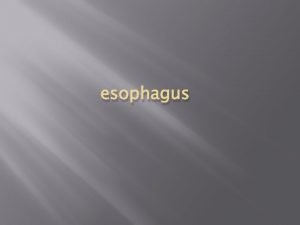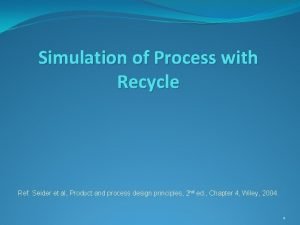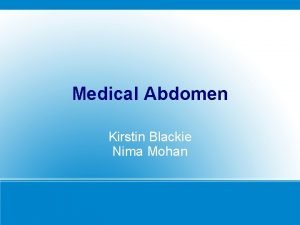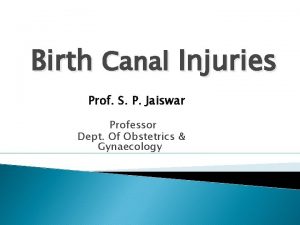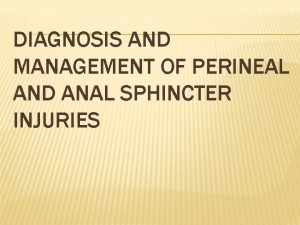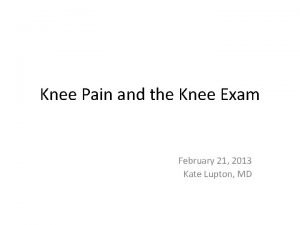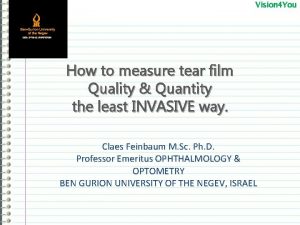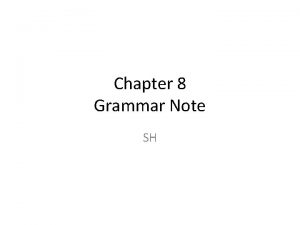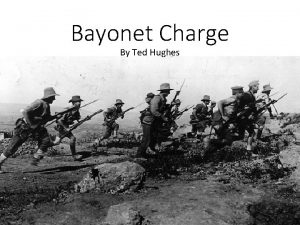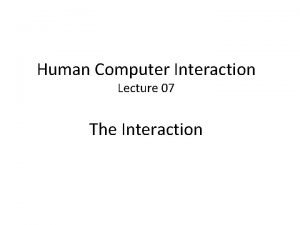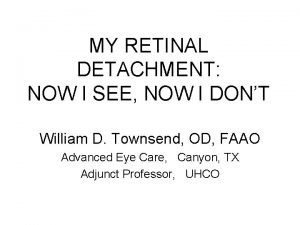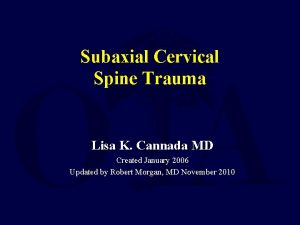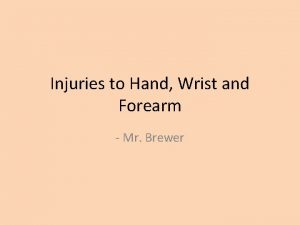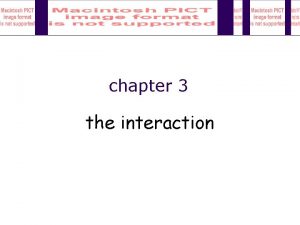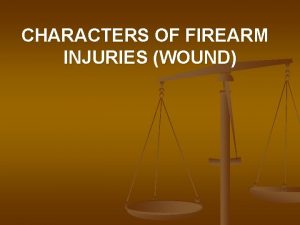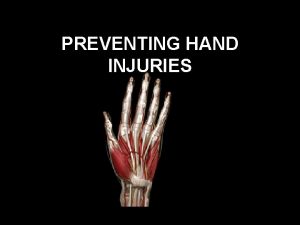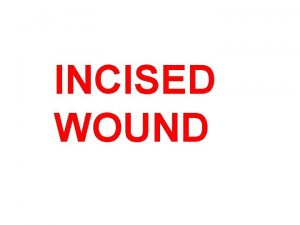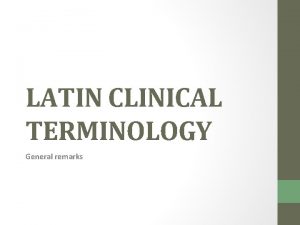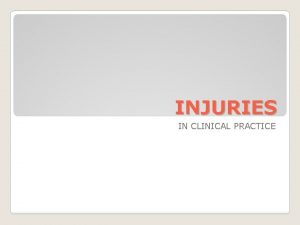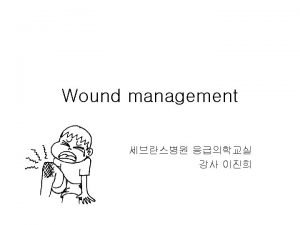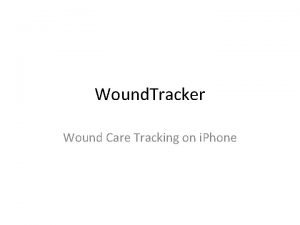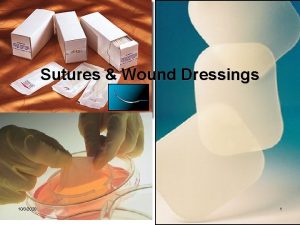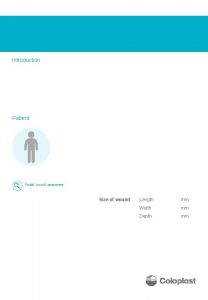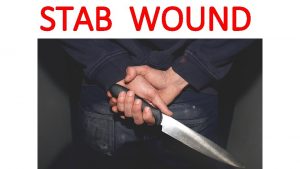INJURIES IN CLINICAL TERMINOLOGY Tear wound a wound





































- Slides: 37

INJURIES IN CLINICAL TERMINOLOGY

Tear wound = a wound produced by the tearing of body tissue. External lacerations may be small or large and may be caused in many ways, such as a blow from a blunt instrument, a fall against a rough surface, or an accident with machinery. Lacerations within the body occur when an organ is compressed or moved out of place by an external or internal force. Vulnus lacerum

Put the words in correct order supercilii - oris - l. - vulnus - sin. - labii - etlacerum - inferioris Ø vulnus lacerum labii inferioris et supercilii l. sin.

Bruise wound = an injury to tissues with skin discoloration and without breakage of skin. Blood from the broken vessels accumulates in surrounding tissues, producing pain, swelling, and tenderness, and the discoloration is the result of blood seepage just under the skin. Haematoma =localized swelling filled with blood Vulnus contusum = contusio

Fill in missing endings is Contusio femor__ is later__ dextr__ e i cum haematomat__

Vulnus contusolacerum = lacerocontusum

Bite wound = usually a puncture or laceration, caused by teeth. An animal bite usually results in a break in the skin but also includes contusions from the excessive pressure on body tissue from the bite. The contusions can occur without a break in the skin. Animal bites often result in serious infections and mortality. Vulnus morsum

Translate the diagnose Bite wounds of the right face after an animal bite ? Ø Vulnera morsa faciei lateris dextri post morsum animalis

cut wound = incision = a wound made by pulling of a sharp instrument, leaving even edges. They may be as minimal as a paper cut or as significant as a surgical incision. or a wound made by a sharp instrument. Vulnus scissum / incisum

Give full forms of the abbreviations and numbers �vv. scissa dig. II-III manus l. sin. Ø vulnera scissa digiti secundi et tertii manus lateris sinistri

A cut wound = a wound caused by falling of a sharp object, typically an axe or a knife. . . Vulnus sectum

A gunshot wound (GSW) (ballistic trauma or bullet wound) = a wound caused by the discharge of arms or munitions. Ballistic trauma can be fatal or cause long-term consequences. Vulnus sclopetarium

stab wound = a specific form of penetrating trauma to the skin that results from a knife or a similar pointed object that is "deeper than it is wide". Stab wounds can occur not only from knives, but also from ice picks, pens, broken bottles, and even coat hangers. Even though stab wounds are inflicted at a much greater rate than gun shot wounds, they account for less than 10% of all penetrating trauma deaths. Vulnus punctum

vulnus ____ regionis _____ vulnera ___________________? ?

vulnus ______? ? ? mors propter ________?


Torn meniscus club foot in a baby = any damage of an organ or tissue that leads to its damagedfunction laesio, onis, f. = permanent bodily malformation of the shape of and organ opart of the body deformitas, atis, f.

laesio – ligamentum – musculus – flexor – digitus – minimus – manus – latus – sinister ENDINGS? ?

vulnus contus__ femor__ dextr__ cum haematomat__ MISSING ENDINGS? ? perforatio membranae tympani status post ___________? ? ?

a strain (of muscle, ligament, etc. ) a scratch or abrasion of skin distensio, onis, f excoriatio, onis, f.

2 nd degree/grade burn 3 rd degree/grade burn infected burns -change in the color of the skin around the burn, swelling, strange odor, the wound sinks deeper into the skin and gets larger, green or yellow pus develops, a fever Combustio, onis, f. = a burn

Write a diagnose of this second degree burn � Combustio antebrachii l. sin. gradus secundi *gradus, m. = degree, stage – always expressed in Genitive!

frostbite Congelatio, onis, f.

Congelatio digiti secundi pedis l. sin. Congelatio auriculae l. dx. / l. sin.

bedsore = a pressure ulcer due to local interference with circulation; persons most at risk are those who are emaciated (nutritionally deficient in protein), obese, immobilized by traction or anything else, diabetic, or suffering from a circulatory disorder. Decubitus, m.

stage 1 pressure ulcer stage 2 pressure ulcer stage 3 pressure ulcer Decubitus, m.

� fractura – luxatio – distorsio � contusio � commotio � perforatio � laceratio � haematoma � abruptio � laesio � distensio Internal injuries

OS = ostesynthesis; FE = ferrum (iron) articulationis sacroiliacae repositionem = severe damage of soft tissues ? ? ? Vulnus contusum/distorsio tali/malleoli l. sin. Luxatio (capitis) humeri l. sin. Bones, ligaments, soft tissues

distorsio, onis, f. = a joint injury in which some of the fibers of a supporting ligament are ruptured but the continuity of the ligament remains intact = a tearing away, separation, or detachment abruptio, onis, f.

epidural haematoma in the left parietal region haematoma epidurale reg. parietalis l. sin. traumatic brain injury (TBI) ? commotio cerebri Organs, soft tissues

partial abruption of placenta in the 36 th week (+ 4 days) of pregnancy? abruptio placentae partialis in grav. hebd. 36+4 in graviditatis hebdomade traumatic perforation of the tympanic membrane in the right ear ? perforatio tympani l. dx. traumatica Organs, soft tissues

laceratio _______? ? contusio lienis mors propter ________? ?


� 1) problem: Nominative ◦ fractura; corpora aliena; subluxatio � 2) localization: Genitive (rarely preposition) ◦ cruris l. dx. ; calcanei; circum genu � 3) further specification of the problem: ◦ traumatica; non dislocata; comminutiva Basic structure of a diagnose

�Side expressed by l. sin. /l. dx. �The specifying adjective usually stands in the end: perforatio tympani l. dx. traumatica �Abbreviations - disloc. , comm. , mult. Specifics of clinical Latin

A three-year-old boy was playing with a plastic ball while in the backseat of a car. The father heard a gasp, saw that the child was unconscious, and suspected the child to aspirate the toy ball. Emergency personnel intubated the child, no foreign body was visualized then. The child was dead on arrival at the hospital. During the postmortem examination, a radiograph of the head and neck showed a spherical foreign body located in the oropharynx. The oropharynx contained a toy soccer ball 2. 5 cm in diameter.

A healthy 25 -year-old man presented to the surgical clinic with a hole in the roof of his mouth, present for a year, and he requested surgical correction. The patient reported a 5 year history of nasal cocaine use from which he had recently abstained. Examination revealed a large perforation of the nasal septum and middle palate. Local complications of intranasal cocaine abuse include chronic rhinitis, sinusitis, epistaxis, ossification or necrosis of the nasal septum, and in rare cases, palatal perforation.
 Challenge word building medical terminology
Challenge word building medical terminology Volere requirements specification template
Volere requirements specification template Tear drop of india
Tear drop of india Esophagus
Esophagus J shaped muscular bag
J shaped muscular bag Recycle
Recycle Tear drop of india
Tear drop of india Episiotomy structures cut
Episiotomy structures cut 5 fs of abdominal distension
5 fs of abdominal distension Periclitoral laceration repair icd 10 pcs
Periclitoral laceration repair icd 10 pcs Torn paper portraits
Torn paper portraits Tear drop of india
Tear drop of india Time model
Time model Mash, grind, mix and tear food.
Mash, grind, mix and tear food. Example of circular letter with tear off slip
Example of circular letter with tear off slip Springer
Springer Bullets smacking the belly out of the air
Bullets smacking the belly out of the air Medial joint line
Medial joint line Meniscus tear sunshine coast
Meniscus tear sunshine coast Tear film layers
Tear film layers Phases of digestion
Phases of digestion Tear drop of india
Tear drop of india Suppose you are shopping for a new backpack
Suppose you are shopping for a new backpack Dacryocystitis
Dacryocystitis Have has
Have has Randomness probability and simulation
Randomness probability and simulation Bullets smacking the belly out of the air
Bullets smacking the belly out of the air Elements of wimp interface in hci
Elements of wimp interface in hci Yard homograph
Yard homograph Horseshoe tear
Horseshoe tear Subaxial
Subaxial Dorsiflexion of wrist
Dorsiflexion of wrist South asia physical features map
South asia physical features map Gluteus medius tear
Gluteus medius tear Palettes and tear-off menus
Palettes and tear-off menus Palettes and tear-off menus
Palettes and tear-off menus Characters of firearm injuries
Characters of firearm injuries Preventing hand injuries
Preventing hand injuries



